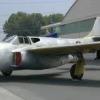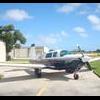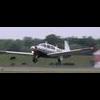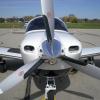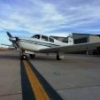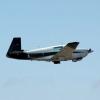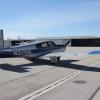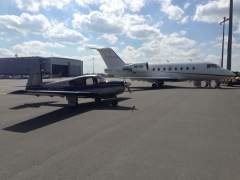Leaderboard
Popular Content
Showing content with the highest reputation on 05/28/2013 in all areas
-
Sky newbie, as a full time professional pilot, I am honored to be talking with a guy who has MANY friends who are pilots. I merely have the humble lower case "several." I agree that you can get checked out post ppl in a complex airplane, it's a little extra work, but as you stated, not rocket science. Granted, those systems need to be operated in a timely manner when the workload is high. But you are also right in that training, and time is the recipie for success. However I think you may not fully appreciate the fast and high flying part yet. Its not the machine, its the environment its operated in, and being able to do so safely and competently is where expirience, judgement and descision making come into play far more than being able to move levers, knobs, sticks and switches.. Asking about control effort when you should asking about things like the endurance of a TKS system if it has one, or the airplanes ability to carry ice when the cards are down Or simply approaching the idea of owning one before having an instrument rating. (which you seem to be shrugging off as a minor technicality. )All point to suggesting that you don't quite have an appreciation for flying in the environment where turbo mooney's were born to fly, and that is why it would be wise to get some time under your belt, and get some ratings before you go write a check and pull a JFK Jr on us. You can absolutley become a safe competent pilot, fully capable of flying pretty much whatever you want, but it is a process that takes time, patience, a healthy respect and a willingness to learn. An open mind makes the process more enjoyable and in many cases faster and more productive. The 17 year old kid getting checked out In a jet, technically possible I suppose. But I personally have never heard of it, however I will give you the benefit of the doubt. I think I get your point, but remember that expirience is measured in hours in the logbook, not candles on your cake for what it's worth. One does not make up for the other... By the way if you look at the tail number in my avatar and reference that M20F for rent at KPAO, you will notice they have something in common. You are more than welcome to fly it obviously. I have it set at $170 an hour TACH right now, it's one heck of a deal. I may prohibit initial complex checkout in the plane in the near future, depending on how things go from a maintiance and abuse standpoint. but as of now, all you need is a membership to WVFC, a PPL, 125TT and 10 hours of checkout time with a phase check.2 points
-
Just to add my two cents remember as Brett pointed out that an aircraft WILL stall at any angle and at any airspeed. This is basic airmanship taught within the first few hours of flight. Maintaining a constant airspeed as bank angle increases will eventually result in a stall. Think accelerated stall. Maintaining wings level as airspeed drops does the same. The really big disaster in a Mooney is when someone decides to do straight and level stalls with their feet lightly on the pedals as opposed to making certain that the ball is centered. That Mooney will snap roll in a heart beat and you will be in a two turn spin in which you best know how to exit. Since spin training is a thing of the past many pilots need to understand that on a base to final (as Mike says) lower the nose to increase airspeed and do not touch flaps until wings level all the while making certain the ball is centered for coordinated flight. One final point take a few minutes with your POH and look at how stall speed increases as bank angle increases and weight increases and flaps increase. It's quite revealing. In my Screamin' Eagle at 3000 lbs there is almost a 30 knot difference between straight and level and 60 degree bank angle as in an overshoot from base to final. The only saving grace for many of us is that we fly light as I am reasonably certain few if any adds 30 knots to their airspeed. So go get those AOA's or go back to basics.2 points
-
I departed Atlanta this morning on an IFR plan in extreme clear VMC. I was assigned 5000ft and vectors. At 4000, I noticed that I was not climbing at Vy. I immediately look at my oil/CHT instruments, prop RPM and EGT -- all normal. I was thinking maybe something weird happened and my valves weren't opening all the way or something. Just as I keyed the mic to ask to return to base, but before I spoke, my hand, nearly subconsciously, advanced the throttle. It had worked its way back because I'd loosened the friction prior to takeoff -- something that I never do. I never bothered to look at my manifold pressure during the diagnostic process. In trainers, I never had the issue as my hand stayed on the throttle, but with the Johnson bar gear, cowl flaps, ram air and flaps, ATC assignments and turning frequencies and the HSI needle and bug, my hand never made it back to the throttle until I needed somewhere to rest it when my left hand took the yoke to key the mic. In my climb, I bet I checked that the gear handle was fully seated in the latch in the floor a half dozen times, and I screwed around with the GNS530 looking at airspace altitudes, checking nearest airports, et cetera. I found it interesting how my mind worked to diagnose the issue and how I neglected verifying MP in the diagnostic process of a loss in engine power. Had I looked at that in my initial scan, or kept it in my scan, I would have discovered it much earlier, but my workload was such that I somehow subconsciously eliminated monitoring the mp and throttle position. I went to oil pressure and temperature first, then EGT to see if I had a dead magneto, but neglected the very thing that had never changed on me in the past. I just wonder how I might have handled the situation had I been in actual IMC, given the only significant workload that I had this morning was Atlanta's airspace and being distracted by looking outside of the airplane. I see how it might happen where you see it in accident reports when a pilot makes a power off landing with the fuel selector on the empty tank when the other one is full. I'll add to say that MP is in my scan during cruise and descent to determine how I lean my mixture, estimate fuel burn and set my power in the descent.1 point
-
Mike I don't want to nit pick but I wanted to point this out so you don't have bad info. Stall speed in a 30 degree bank with gear down and half flaps is 64 kias. So 1.3 is 83 kias not 90+ knots as stated in your post. You may be confusing it for mph? So given that most probably fly a 90 knot base that is a 26 knot buffer at minimum since that figure is computed at gross weight. Flying 90 knots on base to final will protect you up to a 60 degree bank but why would you bank more than 30 degrees in the pattern other than bad technique/poor planning? I'm sure it's on the forum here somewhere but what speeds are most flying the patter at? I shoot for 100 downwind, 90 base, 80 established on final and then 65-70 (Knots) across the proverbial fence. Is this pretty much what other folks are doing? I don't see any need for going any slower around the pattern as she slows down quickly if need be?1 point
-
I think it's a Bendix (now precision) RSA-5 injection system. Key things, make sure a "G" is stamped on the plug on the LH side. The only adjustments are idle mixture and idle speed. Consult the RSA training manual and service manual for details. It's on their site. The screen is located under the fitting for the fuel inlet hose. The larger of the two on the servo unit under the sump. There are also two o-rings you should change when inspecting the screen.1 point
-
I really do not understand what is going on here. Can someone explain. Doesn't have to be facts, opinions will do.1 point
-
I have stayed out of this discussion, especially when it degraded almost to the point of "you are an idiot if you don't agree with me." But, it seems that I am so afraid of an unintended stall situation, that I invariably maneuver at some speed which I believe gives me a wide margin of safety. I think it would be helpful if I had a better idea of how much of a margin I have. I know; if I was a better pilot, I wouldn't need that that assurance. If you are plenty confident, and don't think you need an AOA indicator; great. But I'm seriously considering installing one.1 point
-
I'm a bit more philosophical. I read a lot of posts here about people hemming and hawing between a 201, 232, Rocket, Ovation - what have you. But last Sunday I flew to the Bahamas in my '83 J and it was pure serendipity. Flying high above the islands without a single bump in the sky I said to myself, "it just doesn't get any better than this". For me the 201 is the perfect mix of speed and efficiency and is all this average Joe will ever need.1 point
-
Thanks Bob. The constant was 108. I see what I did wrong. In the words of Forrest Gump "Stupid is as stupid does"! I read the constant as the actual %HP and adjusted it to 70. I'm going back to being a shrimp boat captain...1 point
-
It would help keep you alive a lot more than a shiny new paint job.1 point
-
Are we covering the same topic in two different threads at the same time? Or did I lose my post? -a- Thanks Brett... At least my answer matches my flight instructor's, in the other thread...(mostly)... -a-1 point
-
Sometime a while but your home state seems to be able to find out about a trasnfer faster thant that to collect the taxes.1 point
-
201er, think the FAA tends to agree with you. Last year the accelerated stall was added to the commercial PTS. Basically, starting at an altitude that allows recovery no lower than 3000 AGL, slow the airplane down and trim for straight and level flight at Vx. Then roll into a 45 degree bank and apply back pressure to maintain altitude. If done correctly, you'll get the buffet almost immediately at or very near your entry speed. You've just stalled by increasing the wing's G-loading rather than by allowing airspeed to bleed off to an unaccelerated stall speed, as is typical with power-off and power-on stall training. I remember doing these when I was working on my PPL back in the mid-80s. I may be wrong, but I think they were part of the private PTS back. Take care - Jim1 point
-
Come on guys. Nothing but nothing is going to save somebody from poor piloting technique and lack of understanding. You can throw all kinds of gadgets in the airplane with all kinds of bells and whistles blaring in your ear but in the heat of the moment it's just not going to save that bad/distracted pilot. Fly the airspeeds prescribed in the POH, keep your banks to 30 degrees or less and put your horse back in the barn in one piece. We're not flying transport category aircraft here with huge speed/weight envelopes. However, if you've got money and want another gadget to play with and want to shave that 4 knots off your approach speed to be flying at precisely 1.3 or less to get into that 1200' runway, then have at it. It surely CAN'T hurt.1 point
-
Well it is very rude coming into someone's house and telling them you don't like it. Then offering them a second chance to impress you.1 point
-
In my opinion, an aoa indicator will show you what you already know if you're not distracted but are monitoring and engaged into keeping the airplane within its envelope. Normally, with few risky exceptions, you're within the aoa limits if you're operating inside the envelope. Also an aoa indicator will not act to correct for you. iow, with an aoa readout or not the airplane still can be lost way before corrective action can even be applied. Take the infamous base to final turn. The airplane is at the margin of its envelope, low, slow, dirty and banking. An aoa ind. only confirms this. The fully engaged pilot knows to unload the nose and keep turn coordinated way before the airplane departs its envelope. If this is not done, it's over no matter what! Would aoa info be helpful? Sure! Will it save the day when pilot is distracted and allows the airplane to stray? Probably not! Would I go out of my way to get one? No! This is why, imo, I prefer to actively keep the airplane inside the envelope on my own.1 point
-
You seem obsessed with what you consider as "heavy controls." No offense Skynewbie but what would you know about heavy controls? From what I see, you're still learning to fly. Get your PPL and come back and we'll talk the finer points of flying.1 point
-
Mike, what a great post and I couldn't agree more. However, to say that you had your private license and were not aware that increasing bank increases "stall speed" is hard to fathom. I understand that your instructors probably didn't demonstrate this for you and unfortunately I know that I didn't demonstrate it for my students (although I know we talked about it). When I was actively instructing trying to build time, I knew just barely more than the students I was training. It's just how our system is set up and the flight instructor position is the bottom feeder of the aviation industry. There are exceptions obviously and there are good high time instructors out there. I am just speaking to the "norm". I whole heartedly agree that this is an area that needs addressed though and also agree that an AOA indicator would be a valuable addition to the cockpit especially for those that are looking to do max performance maneuvers. Otherwise, just add a few knots for mom and the kids and all will be well (normal maneuvering). Even with an AOA indicator the stall spin accidents still happen even at the professional level. The company I used to work (and still contract for) lost a Lear 35 in Truckee, CA in 2005. Again, it was a base to final turn that went bad. There were other issues at work and the Lear 35 is very unforgiving. They were turning base to final and I guarantee that as they were doing that they added full flaps. If you don't immediately add power when selecting full flaps you are about to stall the airplane. Add to this that they were in a tight turn and tragedy ensued. The Lear 35 also has a stick shaker and pusher (that is tied to the AOA) but still they had no time to recover. So I guess my point is that even with an AOA that will beep at you, if you get distracted and aren't paying attention it is no guaranteed life saver either. How many folks have landed gear up all the while the aural warning was blaring in the background? http://aviation-safety.net/database/record.php?id=20051228-01 point
-
We are honored that you are giving our beloved Mooneys a second chance....1 point
-
1 point
-
50 knots of wind on the ground in Salina, Kansas is not a huge deal. 50 knots of wind at Angel Fire is deadly. Terrain is the dictator here. As always you have to fly the conditions and environment. You can't just have one set of limitations.1 point
-
That could quite possibly be true. I ran into a flight crew of Air Trek in BUF last year. They were surprisingly forth coming with what a "shady" operation it used to be. A lot of Air Ambulance operators are squeaking by, by doing the absolute minimum. However, it doesn't excuse what an idiot that FAA inspector was. Well that's easy........if your medical says you need glasses then take them with you.1 point



